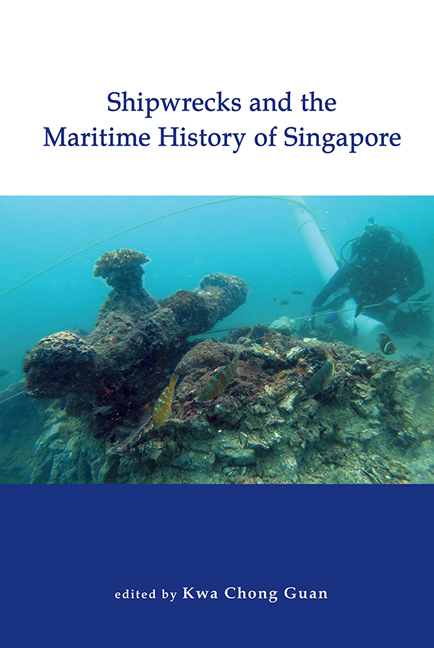Book contents
- Frontmatter
- Contents
- Foreword
- Acknowledgements
- Contributors
- 1 Introduction: Two Historical Shipwrecks and Their Implications for Singapore History
- 2 The Temasek Wreck
- 3 The International History of Temasek: Possibilities for Research Emerging from the Discovery of the Temasek Wreck
- 4 Singapore’s Waterways before the Modern Era
- 5 A Seventeenth-Century Port Settlement in the Kallang Estuary
- 6 The Shah Muncher
- 7 Singapore and the Country Trade in the Late Eighteenth and Early Nineteenth Centuries
- Index
1 - Introduction: Two Historical Shipwrecks and Their Implications for Singapore History
Published online by Cambridge University Press: 01 March 2024
- Frontmatter
- Contents
- Foreword
- Acknowledgements
- Contributors
- 1 Introduction: Two Historical Shipwrecks and Their Implications for Singapore History
- 2 The Temasek Wreck
- 3 The International History of Temasek: Possibilities for Research Emerging from the Discovery of the Temasek Wreck
- 4 Singapore’s Waterways before the Modern Era
- 5 A Seventeenth-Century Port Settlement in the Kallang Estuary
- 6 The Shah Muncher
- 7 Singapore and the Country Trade in the Late Eighteenth and Early Nineteenth Centuries
- Index
Summary
The National Heritage Board (NHB) and the ISEAS – Yusof Ishak Institute announced on 16 June 2021 the successful archaeological excavation of two historic shipwrecks in the eastern approaches to Singapore's waters. The first shipwreck was discovered in 2015 in the course of salvage work on a barge that had run aground on a prominent rock outcrop known for more than a millennium as a major hazard to mariners approaching the Strait of Singapore. The National Heritage Board commissioned the Archaeology Unit of the ISEAS – Yusof Ishak Institute to investigate and then excavate the wreck in 2016. This wreck, intermittently excavated for the next three years, has now been identified from its cargo of Chinese ceramics to be a fourteenth-century vessel most likely headed for Temasek, and therefore named the Temasek Wreck.
A survey and search of the vicinity for other wrecks, commissioned in mid-2019, found a second wreck, which was excavated over the next two years. The second shipwreck has been identified from archival research as an eighteenth-century merchant ship, the Shah Muncher, which was commissioned and owned by the Bombay trader and ship owner Sorabjee Muncherjee Readymoney. It was built in India in 1789 and sank on its return voyage from China to India in 1796 with a diverse cargo of Chinese ceramics and other non-ceramic trade items ranging from glass to copper-alloy objects and umbrellas. There would have been other trade commodities, especially tea, which would have perished. At a thousand tonnes the Shah Muncher was similar in size to the larger East India Company (EIC) ships sailing between England and China.
The essays in this book provide the context of these two wrecks and their implications for our understanding of Singapore history. The two lead essays describing the wrecks and locating them in the context of other contemporary shipwrecks are by Michael Flecker, who brought thirty years of experience and expertise as a marine archaeologist to the excavation of these two shipwrecks. His essays here are summaries of more detailed preliminary reports published by the ISEAS – Yusof Ishak Institute.
- Type
- Chapter
- Information
- Shipwrecks and the Maritime History of Singapore , pp. 1 - 19Publisher: ISEAS–Yusof Ishak InstitutePrint publication year: 2023



